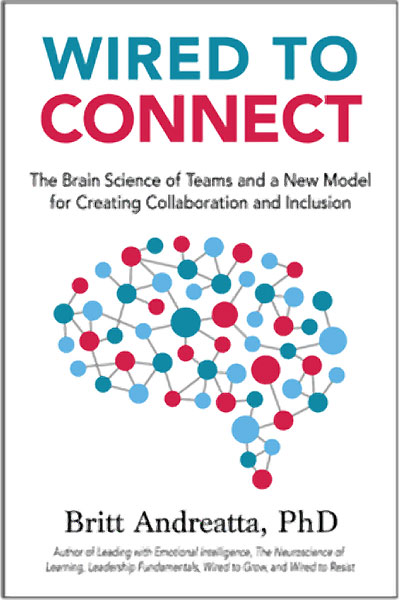This week I’m going off-course a bit from the typical CGNET tech-centric blog post. Last week I attended the TAG2018 (Technology Affinity Group) conference in Tucson. While there, I had the good fortune to hear Dr. Britt Andreatta speak about the brain science of innovation. What an engaging speaker; apparently she also presented last year and was such a hit they invited her back. And what a fascinating topic! I’m hoping to write a post soon about what I learned from her talk about the brain science of innovation.
However, she also discussed parts of her new book “Wired to Connect: The Brain Science of Teams and a New Model for Creating Collaboration and Inclusion”. Because frankly, having a successful (read: happy, fully engaged) team is absolutely crucial to fostering creativity and innovation. Attendees all received a signed copy, and in the past day or so I’ve had time to skim through it. (A deeper and more thorough read is forthcoming for me; I confess I’m a bit of a neuroscience junkie.) But even through my speed-reading, I discovered some interesting things I can share.
Myth: There is no “I” in “team”
Dr. Andreatta starts off “Wired to Connect” with the premise that this iconic expression is outdated and simply wrong. In fact, she asserts, there are actually a lot of “I’s” in a team. A team is made up of individuals who bring their own unique set of perspectives, skills and experiences to the group. And that the best, highest-performing teams “create a cohesive unit through honoring each member’s unique contributions and making them feel included and valued for who they are, as individuals”. She goes on to discuss what teams are like in today’s organizations, and the different ways for them to reach full potential.
This is your brain. This is your brain in a group.
The brain science of teams is a recent field, and medical technology is just catching up. MRIs can only capture the brain activity of a single person. (It gets a little crowded if you try to fit a group in there). But scientists have developed new technologies that solve this problem. They are now able to study the brains of people as they work in groups using sensor-laden caps. The sensors detect activity in regions all over the brain. The data captured from each person’s cap is then overlaid with all of the other group members’ data. What was discovered is that when people engage with each other, their brain waves align. Scientists call this “neural synchrony”. As Dr. Andreatta states in her book, “When conditions are right and we achieve this synchrony, our thoughts and behaviors drive enhanced understanding, effectiveness, and efficiency, even across cultural differences and distance.”
Safety and inclusion
Dr. Andreatta includes two very informative sections on the brain science behind individuals feeling safe, included and trusted in order to reach their fullest potential. These are core human needs, but also exist within the team experience. Once we feel safe (which appeals to our species’ inherent wiring for survival) and as though we belong (satisfying our basic need to bond with others), we can then become. “Becoming”, she states, is when we are able to seek out “our best selves”. As this relates to the team setting, individuals can come together feeling safe, included and trusted, and by doing so can propel both the team and the organization forward without fear of repercussion and/or exclusion. As you might imagine, the opposite is also true. Which is why the strategies in this book can be so meaningful and significant to an organization.
Take your own “learning journey”
Again, as I have only had enough time so far to skim the surface of “Wired to Connect”, I encourage you to consider picking up your own copy of it and diving in. It’s just that interesting! By presenting actual case studies of various types of organizations and providing what Dr. Andreatta calls “Learning Journeys” (thought-provoking exercises) throughout, you get a real feel for the inherent needs of individuals that must be met in order for teams to thrive. Her book wraps up in the final sections by providing a new model for teams known as the Four Gates to Peak Team Performance, and by providing strategies for team leaders, executives, managers and members to cross through those gates. For more information on Dr. Andreatta and the amazing work she has been doing for over 25 years in the fields of neuroscience, leadership and learning, you can go to https://www.brittandreatta.com/.





0 Comments